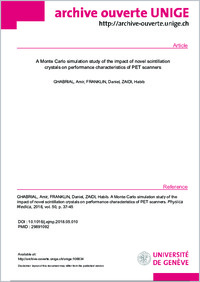A Monte Carlo simulation study of the impact of novel scintillation crystals on performance characteristics of PET scanners.
- Ghabrial A Division of Nuclear Medicine and Molecular Imaging, Geneva University Hospital, CH-1211 Geneva, Switzerland; University of Technology Sydney, Ultimo NSW 2007, Sydney, Australia.
- Franklin D University of Technology Sydney, Ultimo NSW 2007, Sydney, Australia.
- Zaidi H Division of Nuclear Medicine and Molecular Imaging, Geneva University Hospital, CH-1211 Geneva, Switzerland; Geneva Neuroscience Centre, University of Geneva, 1205 Geneva, Switzerland; Department of Nuclear Medicine and Molecular Imaging, University of Groningen, 9700 RB Groningen, Netherlands; Department of Nuclear Medicine, University of Southern Denmark, DK-500 Odense, Denmark. Electronic address: habib.zaidi@hcuge.ch.
- 2018-06-13
Published in:
- Physica medica : PM : an international journal devoted to the applications of physics to medicine and biology : official journal of the Italian Association of Biomedical Physics (AIFB). - 2018
Modelling
Monte Carlo simulations
NEMA standard
PET
Scintillation crystals
Computer Simulation
Monte Carlo Method
Positron-Emission Tomography
English
OBJECTIVE
The purpose of this study is to validate a Monte Carlo simulation model for the clinical Siemens Biograph mCT PET scanner using the GATE simulation toolkit, and to evaluate the performance of six different scintillation materials in this model using the National Electrical Manufactures Association (NEMA) NU 2-2007 protocol.
METHODS
A model of the Biograph mCT PET detection system and its geometry was developed. NEMA NU 2-2007 phantoms were also modelled. The accuracy of the developed scanner model was validated through a comparison of the simulation results from GATE, SimSET and PeneloPET toolkits, and experimental data obtained using the NEMA NU 2-2007 protocols. The evaluated performance metrics included count rate performance, spatial resolution, sensitivity, and scatter fraction (SF). Thereafter, the mCT PET scanner was simulated with six different candidate high-performance scintillation materials, including LSO, LaBr3, CeBr3, LuAP, GLuGAG and LFS-3, and its performance evaluated according to the NEMA NU 2-2007 specifications.
RESULTS
The Monte Carlo simulation model demonstrates good agreement with the experimental data and results from other simulation packages. For instance, the scatter fraction calculated using GATE simulation is 34.35% while the experimentally measured value is 33.2%, 38.48% for the SimSET, and 34.8% for the PeneloPET toolkit. The best-performing scintillation materials were found to be LuAP, LSO and LFS-3, while GLuGAG offers acceptable performance if cost is the dominant concern.
CONCLUSION
The main performance characteristics of the Biograph mCT PET scanner can be simulated accurately using GATE with a good agreement with other Monte Carlo simulation packages and experimental measurements. Newly developed scintillators show promise and offer alternative options for the design of novel generation PET scanners.
The purpose of this study is to validate a Monte Carlo simulation model for the clinical Siemens Biograph mCT PET scanner using the GATE simulation toolkit, and to evaluate the performance of six different scintillation materials in this model using the National Electrical Manufactures Association (NEMA) NU 2-2007 protocol.
METHODS
A model of the Biograph mCT PET detection system and its geometry was developed. NEMA NU 2-2007 phantoms were also modelled. The accuracy of the developed scanner model was validated through a comparison of the simulation results from GATE, SimSET and PeneloPET toolkits, and experimental data obtained using the NEMA NU 2-2007 protocols. The evaluated performance metrics included count rate performance, spatial resolution, sensitivity, and scatter fraction (SF). Thereafter, the mCT PET scanner was simulated with six different candidate high-performance scintillation materials, including LSO, LaBr3, CeBr3, LuAP, GLuGAG and LFS-3, and its performance evaluated according to the NEMA NU 2-2007 specifications.
RESULTS
The Monte Carlo simulation model demonstrates good agreement with the experimental data and results from other simulation packages. For instance, the scatter fraction calculated using GATE simulation is 34.35% while the experimentally measured value is 33.2%, 38.48% for the SimSET, and 34.8% for the PeneloPET toolkit. The best-performing scintillation materials were found to be LuAP, LSO and LFS-3, while GLuGAG offers acceptable performance if cost is the dominant concern.
CONCLUSION
The main performance characteristics of the Biograph mCT PET scanner can be simulated accurately using GATE with a good agreement with other Monte Carlo simulation packages and experimental measurements. Newly developed scintillators show promise and offer alternative options for the design of novel generation PET scanners.
- Language
-
- English
- Open access status
- green
- Identifiers
-
- DOI 10.1016/j.ejmp.2018.05.010
- PMID 29891092
- Persistent URL
- https://folia.unifr.ch/global/documents/46606
Statistics
Document views: 20
File downloads:
- fulltext.pdf: 0
